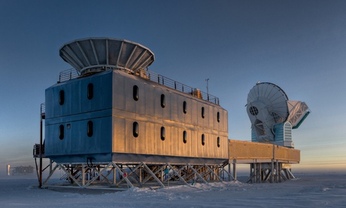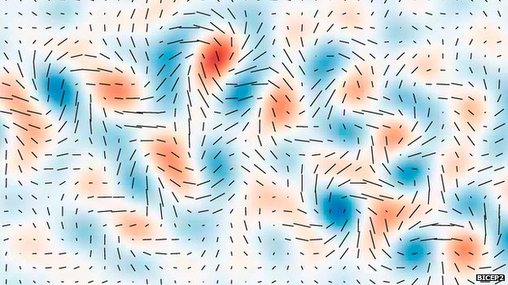 The BICEP2 observatory is located at the South Pole
The BICEP2 observatory is located at the South Pole The observatory, called BICEP2 (after ‘Background Imaging of Cosmic Extragalactic Polarization’), is located at the Amundsen-Scott Station very close to the geographic South Pole. Recent observational data has revealed a particular kind of polarization
of the Cosmic Background Radiation (CBR) which is seen as evidence of gravitational radiation in the very early universe. In particular, theories of cosmic inflation predict the existence of such gravitational radiation, so these results can be assumed to be the first experimental evidence that cosmic inflation actually occurred in the split second after the Big Bang. For observational cosmology, this is a very big deal – and rumours of Nobel Prizes hang in the air for theorists and experimentalists who have championed the idea of cosmic inflation since the early 1980s.
Looking at that last paragraph, there is an awful lot of terminology there to unpack to make any sense of why scientists are getting so excited. So let’s take a step or two backwards to try to clarify why this is (potentially) so
important.
First off then, the current scientific view of the beginning of the Universe is the ‘Big Bang’ (BB). In this event, which is estimated to have occurred about 13.8 billion years ago, all the energy and matter contained in the Universe was created – but more importantly space and time also came into existence. This is an important point, as there seems to be a commonly-held misconception that space and time existed prior to the Big Bang, and that the BB was simply an explosion of matter and energy taking place in this pre-existing space. However, it’s important to understand that the 4-dimensional world which comprises our Universe, which scientists call ‘space-time’, actually came into existence at time zero in the BB, and that the fabric of space-time itself has been expanding ever since, as discovered by Edwin Hubble in the 1920s. This subtle point is discussed briefly in the book How Spacecraft Fly on page 256. So, for example, asking questions about what happened before the BB is
regarded as meaningless as time itself did not exist prior to this event.
 Gravitational waves from inflation put a characteristic 'twist' in the polarization of the CRB.
Gravitational waves from inflation put a characteristic 'twist' in the polarization of the CRB. Einstein’s equations were examined, it was realised that this ‘standard model’
had significant problems.
Principally, in order to get the universe we observe now, the initial conditions at ‘time zero’ has to be precisely specified to about 1 part in 10 to the power of 60 (that’s a big number – 1 with 60 zeros after it). There are essentially two puzzles about how the Universe looks now. The first of these is the puzzle that the Universe looks the same on opposite sides of the sky (isotropy) even though there has not been time since the Big Bang for light (or anything else) to
travel across the Universe and back. So how are physical conditions on opposite horizons "synchronised"? The
second is called the flatness problem. This is the puzzle that the space-time of the Universe is very nearly flat, which means that the Universe sits just on the dividing line between eternal expansion and eventual recollapse. Without getting into the discussion about ‘curved’or ‘warped’ space-time, our Universe appears to be flat – which just means that the Universe obeys the classical rules of geometry set down centuries ago by Euclid (e.g. the internal angles of a triangle add up to 180 degrees etc.).
In the late 1970s / early 1980s a number of cosmologists independently came up with the idea of ‘cosmic inflation’ to attempt to resolve these issues with the ‘standard model’, the principal player being Alan Guth. This refinement to the standard model involves an extremely rapid expansion – an inflation– of the fabric of space-time in the seconds and minutes after the BB. Technically, this is referred to as an exponential expansion - which means that the universe doubles in size at each tick of the clock. From something much smaller than the size of a proton at time zero, it is estimated that space-time grew to about a million billion kilometres across in
less than a minute, and continued growing fast. This rate of growth is actually in excess of the speed of light.
However, Einstein’s speed limit was not violated in this process, as this is the rate of expansion of the fabric of space-time, and not the speed of matter relative to space-time.
Having said all this I am not sure whether we understand the mechanism that drives cosmic inflation – if there is anyone out there who can throw some light on this, that would be helpful. I seem to recall that some of the early vacuum solutions of Einstein’s equations of general relativity, attributed to Willem de Sitter, described models of the Universe with exponential rates of expansion. Clearly the real Universe contains matter, so I don’t know how relevant these de Sitter solutions are. Another possibility is that a different agency, such as dark energy, may have been responsible for cosmic inflation – see for example the discussion of dark energy in the June 21, 2012 blog entry on this website. We suspect that dark energy may be driving the gentle acceleration of the expansion rate that we observe today, and maybe in the early Universe it may have been the mechanism for the much more vigorous inflationary expansion.
If you accept that cosmic inflation occurred in the early Universe, then a consequence of this is the theoretical prediction that gravitational radiation was produced in the process, and this cosmological gravitational radiation
continues to exist in the current era. Gravitational radiation is another consequence of Einstein’s general
relativity. The theory says that this is produced when massive objects, such as stars, move rapidly relative to each other. But what is it? It is worth noting that it is unlike any other radiation with which we are familiar (such as light, or radio waves). The theory predicts that massive objects warp, or distort, the very fabric of space and time, and in certain circumstances the distortion can propagate as a wave, producing gravitational radiation. This is something that we have yet to observe directly, as the technology required to do this is extremely challenging. However, its existence has been confirmed indirectly by observing unusual distant objects, such as the binary system described in the September 1, 2012 blog entry on this website.
The recent observations made by the BICEP2 observatory were directed at measuring a physical characteristic (i.e. a particular kind of polarization caused by the gravitational radiation) of the Cosmic Background Radiation (CBR). The CBR itself has been examined in great detail by a number of ground-based and space-borne observatories – see for example the April 4, 2013 blog entry on this website, which describes the Plank Space Telescope’s observations of the CBR. For thousands of years after the Big Bang the Universe comprised a very hot and dense ‘fireball’, which was opaque to the transmission of light. However, about 380,000 years after the initial event, matter and radiation ‘decoupled’ and the light we now see as the CBR was free to propagate throughout the Universe. Because of the huge degree of expansion of the Universe since, the wavelength of this 'first light' has been stretched so that we now see it as long wavelength microwave radiation with a very low temperature – about 2.7 degrees above absolute zero (absolute zero on the Celsius scale is around -273 degrees).
So finally (and I apologise for the interminable length of this blog post!) I think we have all the bits of the puzzle which I described in the second paragraph above. However, I think it was worth having a go at trying to explain what this is all about as, if the result is confirmed by other observatories, it will be a huge step in the validation of our current understanding of the creation of our Universe. I think what I find extraordinary about all this is that we can make observations in the current era which informs us of the behaviour of the Universe in the split second after time zero when it was a ‘quantum object’ smaller than a proton!

 RSS Feed
RSS Feed
